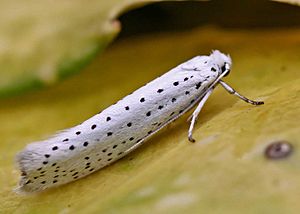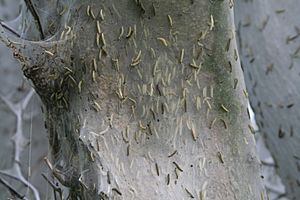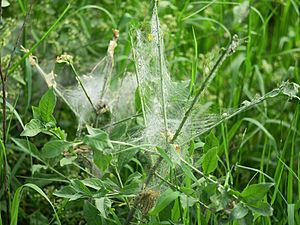Ermine moth facts for kids
The family Yponomeutidae are known as the ermine moths. There are hundreds of different kinds of ermine moths, and most of them live in warm, tropical places. You might also hear other types of moths called "ermine moths," like some snout moths or the "white ermine" moth (which is actually Spilosoma lubricipeda). But the true ermine moths belong to the Yponomeutidae family.
These moths are pretty interesting! Their young, called larvae (or caterpillars), often live together in big, silky webs. While some ermine moths are very beautiful as adults, their larvae can sometimes cause small problems for farmers, in forestry (taking care of forests), and in horticulture (growing plants in gardens). Adult moths also help out by being minor pollinators, which means they help plants make seeds.
Quick facts for kids Ermine moth |
|
|---|---|
 |
|
| Yponomeuta evonymella | |
 |
|
| Communal larval web | |
| Scientific classification |
|
| Kingdom: | Animalia |
| Phylum: | Arthropoda |
| Class: | Insecta |
| Order: | Lepidoptera |
| Superfamily: | Yponomeutoidea |
| Family: | Yponomeutidae Stephens, 1829 |
| Diversity | |
| 600 species | |
There are about five or six main groups, called subfamilies, within the ermine moth family. Some scientists also think the Plutellidae family, which is closely related, should be included as another subfamily.
Contents
Ermine Moth Groups
Here are some of the main subfamilies of ermine moths:
- Saridoscelinae
- Yponomeutinae
What Ermine Moths Look Like
Ermine moths are usually small to medium-sized. Their wings can spread from about 8 to 31 millimeters wide. Their heads are mostly smooth, and they have a special tube (called a haustellum) for drinking nectar.
Their wings are long, and the back edges of their hindwings often have delicate fringes. These moths are usually white, light gray, or dull in color. Many of them have lots of dark spots, which can make them look quite pretty.
Most adult ermine moths are nocturnal, meaning they are active at night.
Ermine Moth Larvae
The larvae of ermine moths are caterpillars that feed on plants. They can be found doing different things on their host plants, like:
- Making webs on leaves
- Eating only the soft parts of leaves, leaving the "skeleton"
- Tunneling inside leaves (called leafminers)
- Tunneling inside pine needles (called needleminers)
Sometimes, these larvae can cause damage to important crops and trees.
Some Ermine Moth Species
Here are a few of the more well-known types of ermine moths:
- Spindle ermine, Yponomeuta cagnagella
- Bird-cherry ermine, Yponomeuta evonymella
- Orchard ermine, Yponomeuta padella
- Yponomeuta plumbella
- Acmosara polyxena
- Apple ermine Yponomeuta malinellus
- Ailanthus webworm
Where the Name Comes From
The name "Yponomeutidae" comes from Ancient Greek words. It combines ὑπό (ypo), which means "under," and νομός (nomós), which means "food" or "dwelling." So, the name basically means "feeding secretly" or "burrowing," which makes sense because their larvae often hide and feed inside plants or in their webs.
See also
 In Spanish: Iponoméutidos para niños
In Spanish: Iponoméutidos para niños


